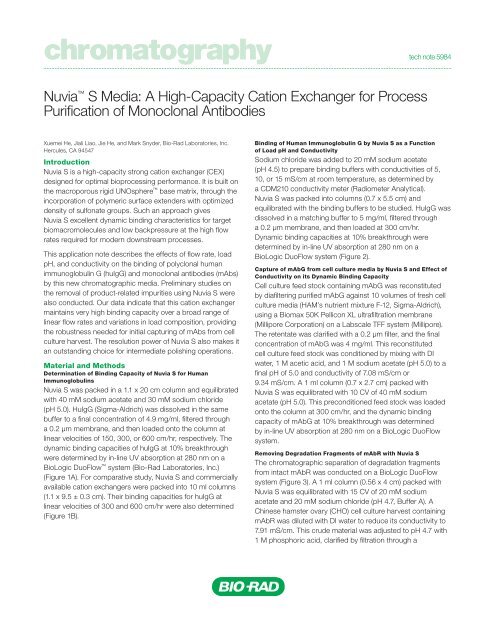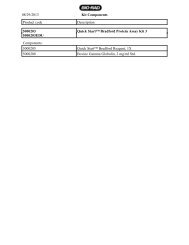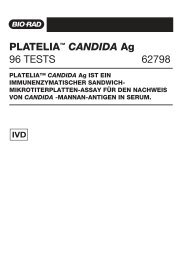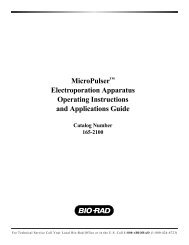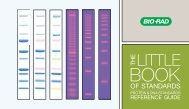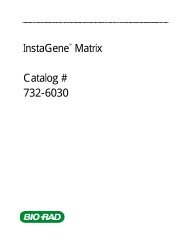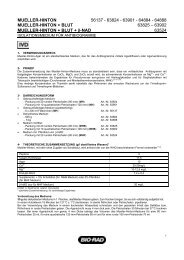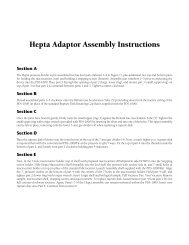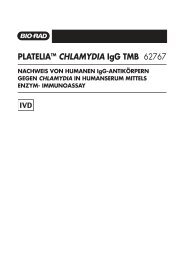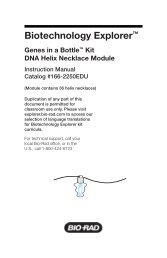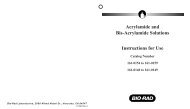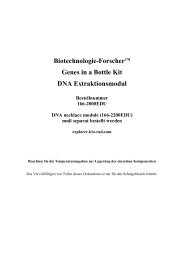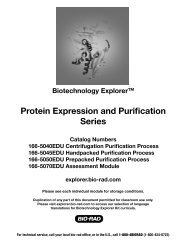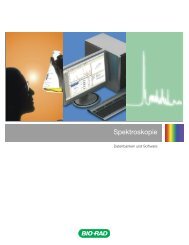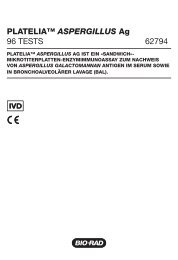chromatography - Bio-Rad
chromatography - Bio-Rad
chromatography - Bio-Rad
You also want an ePaper? Increase the reach of your titles
YUMPU automatically turns print PDFs into web optimized ePapers that Google loves.
<strong>chromatography</strong><br />
Nuvia S Media: A High-Capacity Cation Exchanger for Process<br />
Purification of Monoclonal Antibodies<br />
Xuemei He, Jiali Liao, Jie He, and Mark Snyder, <strong>Bio</strong>-<strong>Rad</strong> Laboratories, Inc.<br />
Hercules, CA 94547<br />
Introduction<br />
Nuvia S is a high-capacity strong cation exchanger (CEX)<br />
designed for optimal bioprocessing performance. It is built on<br />
the macroporous rigid UNOsphere base matrix, through the<br />
incorporation of polymeric surface extenders with optimized<br />
density of sulfonate groups. Such an approach gives<br />
Nuvia S excellent dynamic binding characteristics for target<br />
biomacromolecules and low backpressure at the high flow<br />
rates required for modern downstream processes.<br />
This application note describes the effects of flow rate, load<br />
pH, and conductivity on the binding of polyclonal human<br />
immunoglobulin G (huIgG) and monoclonal antibodies (mAbs)<br />
by this new chromatographic media. Preliminary studies on<br />
the removal of product-related impurities using Nuvia S were<br />
also conducted. Our data indicate that this cation exchanger<br />
maintains very high binding capacity over a broad range of<br />
linear flow rates and variations in load composition, providing<br />
the robustness needed for initial capturing of mAbs from cell<br />
culture harvest. The resolution power of Nuvia S also makes it<br />
an outstanding choice for intermediate polishing operations.<br />
Material and Methods<br />
Determination of Binding Capacity of Nuvia S for Human<br />
Immunoglobulins<br />
Nuvia S was packed in a 1.1 x 20 cm column and equilibrated<br />
with 40 mM sodium acetate and 30 mM sodium chloride<br />
(pH 5.0). HuIgG (Sigma-Aldrich) was dissolved in the same<br />
buffer to a final concentration of 4.9 mg/ml, filtered through<br />
a 0.2 μm membrane, and then loaded onto the column at<br />
linear velocities of 150, 300, or 600 cm/hr, respectively. The<br />
dynamic binding capacities of huIgG at 10% breakthrough<br />
were determined by in-line UV absorption at 280 nm on a<br />
<strong>Bio</strong>Logic DuoFlow system (<strong>Bio</strong>-<strong>Rad</strong> Laboratories, Inc.)<br />
(Figure 1A). For comparative study, Nuvia S and commercially<br />
available cation exchangers were packed into 10 ml columns<br />
(1.1 x 9.5 ± 0.3 cm). Their binding capacities for huIgG at<br />
linear velocities of 300 and 600 cm/hr were also determined<br />
(Figure 1B).<br />
tech note 5984<br />
Binding of Human Immunoglobulin G by Nuvia S as a Function<br />
of Load pH and Conductivity<br />
Sodium chloride was added to 20 mM sodium acetate<br />
(pH 4.5) to prepare binding buffers with conductivities of 5,<br />
10, or 15 mS/cm at room temperature, as determined by<br />
a CDM210 conductivity meter (<strong>Rad</strong>iometer Analytical).<br />
Nuvia S was packed into columns (0.7 x 5.5 cm) and<br />
equilibrated with the binding buffers to be studied. HuIgG was<br />
dissolved in a matching buffer to 5 mg/ml, filtered through<br />
a 0.2 μm membrane, and then loaded at 300 cm/hr.<br />
Dynamic binding capacities at 10% breakthrough were<br />
determined by in-line UV absorption at 280 nm on a<br />
<strong>Bio</strong>Logic DuoFlow system (Figure 2).<br />
Capture of mAbG from cell culture media by Nuvia S and Effect of<br />
Conductivity on its Dynamic Binding Capacity<br />
Cell culture feed stock containing mAbG was reconstituted<br />
by diafiltering purified mAbG against 10 volumes of fresh cell<br />
culture media (HAM’s nutrient mixture F-12, Sigma-Aldrich),<br />
using a <strong>Bio</strong>max 50K Pellicon XL ultrafiltration membrane<br />
(Millipore Corporation) on a Labscale TFF system (Millipore).<br />
The retentate was clarified with a 0.2 μm filter, and the final<br />
concentration of mAbG was 4 mg/ml. This reconstituted<br />
cell culture feed stock was conditioned by mixing with DI<br />
water, 1 M acetic acid, and 1 M sodium acetate (pH 5.0) to a<br />
final pH of 5.0 and conductivity of 7.08 mS/cm or<br />
9.34 mS/cm. A 1 ml column (0.7 x 2.7 cm) packed with<br />
Nuvia S was equilibrated with 10 CV of 40 mM sodium<br />
acetate (pH 5.0). This preconditioned feed stock was loaded<br />
onto the column at 300 cm/hr, and the dynamic binding<br />
capacity of mAbG at 10% breakthrough was determined<br />
by in-line UV absorption at 280 nm on a <strong>Bio</strong>Logic DuoFlow<br />
system.<br />
Removing Degradation Fragments of mAbR with Nuvia S<br />
The chromatographic separation of degradation fragments<br />
from intact mAbR was conducted on a <strong>Bio</strong>Logic DuoFlow<br />
system (Figure 3). A 1 ml column (0.56 x 4 cm) packed with<br />
Nuvia S was equilibrated with 15 CV of 20 mM sodium<br />
acetate and 20 mM sodium chloride (pH 4.7, Buffer A). A<br />
Chinese hamster ovary (CHO) cell culture harvest containing<br />
mAbR was diluted with DI water to reduce its conductivity to<br />
7.91 mS/cm. This crude material was adjusted to pH 4.7 with<br />
1 M phosphoric acid, clarified by filtration through a
0.2 μm filter, and then loaded onto the pre-equilibrated<br />
column at 300 cm/hr. The post-loading wash was performed<br />
with 15 CV of Buffer A, followed by 15 CV of 20 mM sodium<br />
acetate and 76 mM sodium chloride (pH 4.7, Buffer B).<br />
The bound mAbR was eluted in 15 CV of 20 mM sodium<br />
acetate and 188 mM sodium chloride (pH 4.8, Buffer C). The<br />
used column was stripped with 5 CV of 1 N NaOH. Protein<br />
fractions were analyzed by SDS-PAGE under reducing<br />
conditions, using a Criterion Tris-HCl 4–20% gradient gel<br />
(<strong>Bio</strong>-<strong>Rad</strong>) followed by staining with <strong>Bio</strong>-Safe Coomassie<br />
stain (<strong>Bio</strong>-<strong>Rad</strong>). Impurities in fractions collected during<br />
the Buffer B wash were identified by mass spectroscopy<br />
using an Autoflex II MALDI-TOF mass spectrometer (Bruker<br />
Corporation). These column fractions were pooled and<br />
analyzed with a size-exclusion high performance liquid<br />
<strong>chromatography</strong> (SEC-HPLC) column on a <strong>Bio</strong>Logic DuoFlow<br />
system. The integrity of mAbR recovered in the eluate pool<br />
was also examined in the same manner.<br />
Removing High Molecular Weight Aggregates of mAbG with<br />
Nuvia S<br />
The chromatographic separation of high molecular weight<br />
aggregates from monomeric mAbG was performed on a<br />
<strong>Bio</strong>Logic DuoFlow system (Figure 4). A 1 ml column (0.56 x 4<br />
cm) packed with Nuvia S was equilibrated with Buffer A.<br />
A mAbG stock solution was diluted with DI water to reduce<br />
its conductivity to 4.4 mS/cm, followed by pH adjustment to<br />
4.7 with 1 M acetic acid. This solution was then loaded<br />
onto the column at 300 cm/hr. After washing with 5 CV of<br />
20 mM sodium acetate and 160 mM sodium chloride (pH 4.7,<br />
Buffer D), mAbG was eluted in 20 mM sodium acetate and<br />
245 mM sodium chloride (pH 4.9, Buffer E). Three CV of 1 N<br />
NaOH were used to strip the column following purification.<br />
Contents of high molecular weight aggregates in the load and<br />
eluate pool from Nuvia S were analyzed using the SEC-HPLC<br />
method described above.<br />
Results and Discussion<br />
Nuvia S, like all UNOsphere-based <strong>chromatography</strong> media,<br />
is characterized by its excellent flow properties and fast<br />
mass transfer. Surface extenders grafted into the pore space<br />
of the Nuvia S matrix make the sulfonic acid ligands more<br />
available to electrostatic interaction with opposite charges on<br />
the incoming antibody molecules. As shown in Figure 1,<br />
Nuvia S exhibited efficient binding for huIgG in the linear<br />
velocity range of 150 to 600 cm/hr, significantly outperforming<br />
all commercial CEX media tested. The huIgG binding capacity<br />
on Nuvia S was found to be 114 mg/ml even at a high flow<br />
rate of 600 cm/hr. Such performance allows Nuvia S to deliver<br />
the speed and throughput needed in process manufacturing<br />
of mAbs. For initial capture, operation at high flow-rates offers<br />
an additional advantage of minimizing the target antibody’s<br />
exposure to proteases and nucleases present in the cell<br />
culture feedstream.<br />
Fig. 1. Binding of huIgG by Nuvia S media at various linear velocities.<br />
A, binding on a Nuvia S column (1.1 x 20 cm). B, comparison of Nuvia S with<br />
commercially available CEX media. (—), Nuvia S; (—), CEX 1; (—), CEX 2;<br />
(—), CEX 3. Column size, 1.1 x 9.5 ± 0.3 cm.<br />
© 2010 <strong>Bio</strong>-<strong>Rad</strong> Laboratories, Inc. Bulletin 5984<br />
A<br />
240<br />
10% Breakthrough (huIgG), mg/ml<br />
10% Breakthrough (huIgG), mg/ml<br />
220<br />
200<br />
180<br />
160<br />
140<br />
120<br />
100<br />
80<br />
B<br />
140<br />
60<br />
150 200 250 300 350 400 450 500 550 600<br />
130<br />
120<br />
110<br />
100<br />
90<br />
80<br />
70<br />
300 350 400 450<br />
Linear velocity, cm/hr<br />
500 550 600<br />
The pI value of a monoclonal antibody as well as the pH and<br />
conductivity of the product pool determine the charge state<br />
of both antibody molecules and ligands on CEX media, and<br />
hence the strength of electrostatic interaction between them.<br />
The effect of load conductivity was studied at three different<br />
pH values. At pH 4.5, the maximal binding capacity of huIgG<br />
on Nuvia S was achieved at 10 mS/cm instead of 5 mS/cm,<br />
which is contradictory to the intuitive belief that binding to<br />
CEX media is promoted by lowering buffer conductivity. This<br />
phenomenon has been well documented and thoroughly<br />
studied (Harinarayan et al. 2006, Stone and Carta 2007,<br />
Stone et al. 2009, Tao and Carta 2008, Yuan et al. 2000). In<br />
our experiments, increasing operation pH to 5.0 led to higher<br />
binding capacity of huIgG at 5 mS/cm. However, further<br />
elevation of conductivity or pH weakened the interaction<br />
between huIgG and charged functionalities on the media,<br />
resulting in a dramatic decrease in binding capacity at<br />
15 mS/cm or pH 5.5 (Figure 2).<br />
In light of the interdependence of load pH and conductivity,<br />
dynamic binding capacity of a mAb should be determined<br />
with multiple pH-conductivity combinations during design of<br />
experiments (DoE) process development and optimization.
10% Breakthrough (huIgG), mg/ml<br />
140<br />
120<br />
100<br />
80<br />
60<br />
40<br />
20<br />
0<br />
4.5<br />
5.0<br />
pH<br />
Fig. 2. Dynamic binding capacity of huIgG by Nuvia S media as a<br />
function of load, pH, and conductivity. Nuvia S was packed into 0.7 x 5.5<br />
cm columns and equilibrated with the appropriate binding buffer. HuIgG was<br />
loaded in the same buffer at a flow rate of 300 cm/hr.<br />
AU<br />
Rack Pos.:<br />
Tube #:<br />
2.50<br />
2.50<br />
2.00<br />
2.00<br />
1.50<br />
1.50<br />
1.00<br />
1.00<br />
0.50<br />
0.50<br />
0.00<br />
0.00<br />
–0.50<br />
-0.50<br />
AU<br />
A B<br />
Flow through<br />
5.5<br />
30 60<br />
Time, min<br />
90<br />
30.00 60.00 90.00<br />
Min.Tenth<br />
5<br />
10<br />
15<br />
Conductivity, mS/cm<br />
A typical mAb harvest from mammalian expression culture<br />
contains a substantial amount of sodium chloride, requiring<br />
preconditioning or in-line dilution to reduce its conductivity<br />
before loading onto a cation exchange column. Sensitivity<br />
to conductivity may be different for individual mAbs. At<br />
pH 5.0, the binding of a basic monoclonal antibody mAbG<br />
by Nuvia S was tested at 7.1 and 9.3 mS/cm, which<br />
corresponds to 50–75 mM of sodium chloride in solution.<br />
A B<br />
1 2 3 4 5 6 7 8 9 10 111213141516 17 18<br />
Buffer B wash<br />
fractions<br />
2 3 4 5 6 7 8 9<br />
3.50<br />
3.50<br />
350.0 350<br />
Buffer C<br />
elution<br />
3.00<br />
3.00<br />
1 N NaOH<br />
strip<br />
300.0 300<br />
Buffer B<br />
wash<br />
The 10% breakthrough binding capacity decreased only<br />
slightly, from 130 to 115 mg/ml, when conductivity was<br />
changed from 7.1 to 9.3 mS/cm, providing consistent<br />
capture of mAbG with Nuvia S over a relatively wide<br />
conductivity window.<br />
Chromatographic purification of mAbR with a Nuvia S column<br />
is shown in Figure 3. Initial elution studies using a linear<br />
gradient revealed that some contaminants were weakly<br />
bound by this media. They could be selectively desorbed<br />
from the column by low ionic strength buffers (data not<br />
shown). A step elution protocol was developed on the basis<br />
of this finding (Figure 3A). The predominant impurity, removed<br />
by a wash step with Buffer B (Figure 3B), was identified by<br />
MALDI-TOF mass spectrometry as a degradation fragment<br />
from mAbR’s L chain. The intact mAbR was recovered in a<br />
salt-step elution by Buffer C (Figure 3B), free of fragments or<br />
aggregates as revealed by SEC-HPLC analysis (Figure 3C).<br />
The potential use of Nuvia S for the clearance of higherorder<br />
mAb structures has been explored using mAbG, a<br />
monoclonal antibody that tends to aggregate during acidic<br />
elution from a Protein A affinity chromatographic column.<br />
The loaded material in this study contained 13.8% of mAbG<br />
aggregates. A salt-step elution was designed to recover<br />
monomeric mAbG, while retaining aggregates on the column<br />
until stripping with 1 N NaOH (Figure 4). The overall yield of<br />
monomeric mAbG in such chromatographic preparation was<br />
93%, and the aggregate contamination level was effectively<br />
reduced to
AU<br />
A B<br />
Rack Pos.:<br />
Tube #:<br />
2.00<br />
1 2 3 4 5 6 7 8 9 10 11 12 13 14 15<br />
2.00<br />
1.75<br />
1.75<br />
1.50<br />
1.50<br />
1.25<br />
1.25<br />
1.00<br />
1.00<br />
0.75<br />
0.75<br />
0.50<br />
0.50<br />
0.25<br />
0.25<br />
0.00<br />
0.00<br />
–0.25<br />
-0.25<br />
AU<br />
0.00 10.00 20.00 30.00 40.00<br />
0 10 20 30 40<br />
AU<br />
Min.Tenth<br />
Life Science<br />
Group<br />
0.0125<br />
0.0100<br />
0.0075<br />
0.0050<br />
0.0025<br />
0.0000<br />
–0.0025<br />
Bulletin 5984 Rev A US/EG<br />
SEC-HPLC Analysis<br />
Load<br />
Fractions 3-8<br />
11.00 12.00<br />
Min.Tenth<br />
13.00<br />
Buffer A equilibration<br />
0.0125<br />
0.0100<br />
0.0075<br />
0.0050<br />
0.0025<br />
0.0000<br />
AU<br />
–0.0025<br />
<strong>Bio</strong>-<strong>Rad</strong><br />
Laboratories, Inc.<br />
Buffer D<br />
wash<br />
Time, min<br />
Buffer E<br />
elution<br />
Conclusion<br />
Increasing process productivity and reducing operating<br />
costs continue to be the driving forces in process<br />
development. Recent advances in upstream processes<br />
have dramatically improved the productivity of cell culture<br />
fermentation. However, prolonged fermentation and high<br />
concentration of mAb molecules at harvest may also lead<br />
to product degradation and/or aggregation. These are the<br />
latest challenges for downstream processing of such drug<br />
materials. Binding capacity and purification performance<br />
are the most important considerations in selecting<br />
chromatographic media. Media with high capacity for target<br />
molecules and resolution power for impurity clearance are<br />
in demand. Our new high-capacity strong cation exchanger<br />
Nuvia S is suitable for both capturing and polishing steps<br />
in the manufacturing of monoclonal antibodies over a wide<br />
range of operating conditions. It offers the capacity and<br />
speed for processing large load volume with smaller columns<br />
and less buffer consumption. Additionally, Nuvia S is an<br />
exceptional tool for removing product-related contaminants<br />
such as mAb fragments and aggregates.<br />
1N NaOH<br />
strip<br />
Fig. 4. Intermediate polishing of mAbG<br />
by Nuvia S media: Removal of mAbG<br />
aggregates. Both loaded material and<br />
pooled eluate fractions were analyzed by<br />
SEC-HPLC to assess the contamination<br />
level of mAbG aggregates. (—), OD 280 ;<br />
(—), conductivity; (—), salt steps.<br />
Web site www.bio-rad.com USA 800 424 6723 Australia 61 2 9914 2800 Austria 01 877 89 01 Belgium 09 385 55 11 Brazil 55 11 5044 5699<br />
Canada 905 364 3435 China 86 21 6169 8500 Czech Republic 420 241 430 532 Denmark 44 52 10 00 Finland 09 804 22 00<br />
France 01 47 95 69 65 Germany 089 31 884 0 Greece 30 210 9532 220 Hong Kong 852 2789 3300 Hungary 36 1 459 6100 India 91 124 4029300<br />
Israel 03 963 6050 Italy 39 02 216091 Japan 03 6361 7000 Korea 82 2 3473 4460 Mexico 52 555 488 7670 The Netherlands 0318 540666<br />
New Zealand 64 9 415 2280 Norway 23 38 41 30 Poland 48 22 331 99 99 Portugal 351 21 472 7700 Russia 7 495 721 14 04<br />
Singapore 65 6415 3188 South Africa 27 861 246 723 Spain 34 91 590 5200 Sweden 08 555 12700 Switzerland 061 717 95 55<br />
Taiwan 886 2 2578 7189 Thailand 800 88 22 88 United Kingdom 020 8328 2000<br />
500<br />
500.0<br />
400<br />
400.0<br />
300<br />
300.0<br />
200<br />
200.0<br />
100<br />
100.0<br />
0<br />
0.0<br />
–100<br />
-100.0<br />
mS/cm<br />
mS/cm<br />
References<br />
Harinarayan C et al. (2006). An exclusion mechanism in ion exchange<br />
<strong>chromatography</strong>. <strong>Bio</strong>technol <strong>Bio</strong>eng 95, 775–787.<br />
Stone MC and Carta G (2007). Protein adsorption and transport in agarose<br />
and dextran-grafted agarose media for ion exchange <strong>chromatography</strong>. J<br />
Chromatogr A 1146, 202–215.<br />
Stone MC et al. (2009). Protein adsorption and transport in agarose and<br />
dextran-grafted agarose media for ion exchange <strong>chromatography</strong>: Effect of<br />
ionic strength and protein characteristics. J Chromatogr A 1216, 4465–4474.<br />
Tao Y and Carta G (2008). Rapid monoclonal antibody adsorption on dextrangrafted<br />
agarose media for ion-exchange <strong>chromatography</strong>. J Chromatogr<br />
A 1211, 70–79.<br />
Yuan Y et al. (2000). Size does matter: Electrostatically determined surface<br />
coverage trends in protein and colloid adsorption. Colloids and Surfaces A:<br />
Physicochemical and Engineering Aspects 165, 125–141.<br />
<strong>Bio</strong>max, Pellicon, and Labscale are trademarks of Millipore Corporation.<br />
Coomassie is a trademark of BASF Aktiengesellshaft.<br />
Autoflex is a trademark of Bruker Corporation.<br />
Information in this tech note was current as of the date of writing (2010) and<br />
not necessarily the date this version (rev A, 2010) was published.<br />
12-1770 1012 Sig 1211


